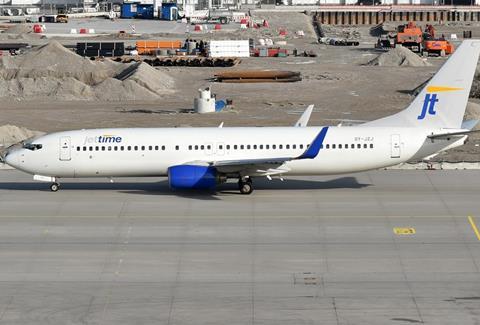Danish investigators have determined that the additional fuel consumption arising from stuck flaps resulted in a diverted Boeing 737-800’s landing at Copenhagen with less than the required minimum fuel reserve.
The aircraft – operated by Danish carrier Jettime – had been conducting an approach to Billund following a charter service from the Egyptian resort of Hurghada on 21 December last year.
Investigation authority Havarikommissionen says a sensor glitch, subsequently resolved, delayed the 737’s departure from Hurghada by 28h.
When the crew updated the flightplan they based it on a minimum fuel requirement of 16,814kg although the carrier’s operational control centre communicated a revised figure of 17,400kg owing to a new winds aloft forecast.
The crew did not manage to update the flightplan with the winds forecast but – while continuing to use the basic figure of 16,814kg – chose to add 1,186kg of extra fuel to account for the winds forecast, the technical snag, and the possibility of storms on arrival in Denmark.
Danish investigation authority Havarikommissionen says this extra fuel provided a “reasonable operating margin”.
But as the flight progressed the crew noticed a reduction in estimated landing fuel – from 4,000kg to 3,200kg – owing to stronger-than-expected headwinds, and opted to change their alternate airport from Gothenburg to the closer Copenhagen.
The aircraft had 3,278kg of fuel on board when it conducted its ILS approach to Billund’s runway 27, in strong gusting winds from the northwest.

Although the 737 was stable, the crew received a windshear warning at 300ft and executed a go-around. But although 15° flap was selected, the position indicator showed 13° and the crew started running the ‘flap disagree’ checklist before advising they were diverting to Copenhagen.
The aircraft was cleared to 18,000ft and an approach to Copenhagen’s runway 30. Revised fuel calculations, based on the abnormal configuration, indicated a flight time of 20min and remaining fuel for 38min.
Required minimum final reserve fuel was 1,118kg and the crew declared a fuel emergency, with controllers suggesting Roskilde as a possible alternative landing site. The pilots opted to continue to Copenhagen, based on weather conditions, and the aircraft landed safely with 999kg of fuel remaining. None of the 185 occupants was injured.
Quick-access recorder data indicated that the aircraft had experienced four instances of flap overspeed during the go-around, one of which coincided with the crew’s movement of the flap handle to 15°.
Boeing designed the aircraft with a load-relief system which prevents flap damage, by retracting the flaps by one detent, if overspeed is sensed. But if the crew commanded a similar retraction at the same time, it found, the load-relief solenoid might fail to reset.
The inquiry believes this failure caused the flaps to retract beyond the 15° selection, to 13°, which then registered as an uncommanded movement – causing the power to be removed from the flap drive as a precaution.
Although an updated solenoid valve was developed to address the issue, the replacement was not mandatory and those on the aircraft involved had not been changed.
Owing to the abnormal configuration, the diversion fuel from Billund to Copenhagen increased from a calculated 1,478kg to an actual burn of 2,091kg.


























